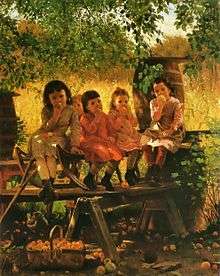John George Brown
.jpg)

John George Brown (November 11, 1831 – February 8, 1913) was a British citizen and an American painter born in Durham, England on November 11, 1831. His parents apprenticed him to the career of glass worker at the age of fourteen in an attempt to dissuade him from pursuing painting.[1] He studied nights at the School of Design in Newcastle-on-Tyne while working as a glass cutter there between 1849 and 1852 and evenings at the Trustees Academy in Edinburgh while working at the Holyrood Glass Works between 1852 and 1853.[2] After moving to New York City in 1853, he studied with Thomas Seir Cummings at the National Academy of Design where he was elected a National Academician in 1861. Brown was the Academy's vice-president from 1899 to 1904.[3]
Around 1855, he worked for the owner of the Brooklyn Glass Company, and later he married the daughter of his employer. His father-in-law encouraged his artistic abilities, supporting him financially, letting Brown pursue painting full-time.[1] In 1866, he became one of the charter members of the Water-Color Society, of which he was president from 1887 to 1904. Brown became famous for his depictions of street urchins found on the streets of New York (bootblacks, street musicians, posy sellers, newsboys, etc.).[4]
His Passing Show (Paris, Salon, 1877) and Street Boys at Play (Paris Exhibition, 1900) are good examples of his popular talent. Brown's art is best characterized as British genre paintings adapted to American subjects. Essentially literary, Brown's paintings are executed with precise detail, but poor in color, and more popular with the general public than with connoisseurs.
Quotes
- Wishing to more faithfully capture his subjects as they appeared in real life, Brown once said, "They will change their dress, as though to show the extent of their wardrobe. Being cautioned expressly on Saturday, and told to return in the same fustian jacket your boy will appear on Monday morning, if he appears at all, in a red woolen shirt. And they are constantly having their hair trimmed--perfect dandies!"[4]
- Brown was trying to capture the spirit of the street children as people who "pull themselves up by their bootstraps."[4]
- Many years later, Brown claimed that most of the street children he painted had grown to become successful businessmen.[4]
- Brown claimed to bobbies, "I do not paint poor boys solely because the public likes such pictures and pays me for them, but because I love the boys myself, for I, too, was once a poor lad like them."
Brown was one of the most successful genre painters of the late 19th century. He worked as a glassblower in Brooklyn and proceeded to open a studio in 1860, launching his artistic career with a painting entitled "His First Cigar". His paintings of cheery street urchins, vendors and shoeshine boys were quite popular with wealthy collectors. However, Brown falsified his subjects as always happy and healthy with just a touch of grime for cosmetics. These scenes were really below his artistic ability, but Brown did not want to cause social alarm among patrons. Many of Brown's paintings were reproduced in lithography and widely distributed with packaged teas. The royalties earned from one lithograph were $25,000. Brown's financial success allowed for him to paint country landscape paintings for pleasure. John George Brown exhibited many of his paintings at the National Academy of Design from 1858–1900, where he also taught for many years.
References
- 1 2 Birmingham Museum of Art (1993). Masterpieces East and West: from the Collection of the Birmingham Museum of Art. Birmingham, Alabama. p. 202. ISBN 0-931394-37-6. Retrieved 2011-07-16.
- ↑ Maddox, Kenneth W., "Biography and Works: John George Brown," http://www.museothyssen.org/en/thyssen/ficha_artista/101
- ↑ National Academy Museum and School (2010). "National Academy Museum and School of Fine Arts". National Academy. Retrieved 2011-06-24.
- 1 2 3 4 Birmingham Museum of Art (2010). Birmingham Museum of Art: A Guide to the Collection. London: Giles. p. 129. ISBN 978-1-904832-77-5. Retrieved 2011-06-24.
 This article incorporates text from a publication now in the public domain: Chisholm, Hugh, ed. (1911). "Brown, John George". Encyclopædia Britannica (11th ed.). Cambridge University Press.
This article incorporates text from a publication now in the public domain: Chisholm, Hugh, ed. (1911). "Brown, John George". Encyclopædia Britannica (11th ed.). Cambridge University Press. This article incorporates text from a publication now in the public domain: Gilman, D. C.; Thurston, H. T.; Colby, F. M., eds. (1905). "article name needed". New International Encyclopedia (1st ed.). New York: Dodd, Mead.
This article incorporates text from a publication now in the public domain: Gilman, D. C.; Thurston, H. T.; Colby, F. M., eds. (1905). "article name needed". New International Encyclopedia (1st ed.). New York: Dodd, Mead.
External links
| Wikimedia Commons has media related to John George Brown. |
| Wikisource has the text of the 1911 Encyclopædia Britannica article Brown, John George. |